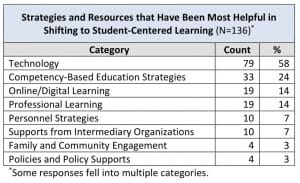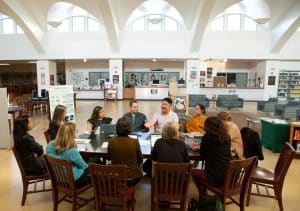Strategies for Shifting to Student-Centered Learning from the Aurora Institute Annual Survey
CompetencyWorks Blog
Each year the Aurora Institute conducts a survey of our network of members, event attendees, and stakeholders in our database as an important source of information from the field about our policy and practice work. Thank you to everyone who responded.
This blog post reports on responses to the question, “What strategies, resources, or tools (including tech tools or platforms) have been most helpful in shifting to student-centered, anytime, anywhere learning?” The table below summarizes the responses, followed by details of specific strategies and resources.

Technology
Technology tools were mentioned in helping the shift to student-centered and anytime, anywhere learning more often than any other category, unsurprisingly in this year of extensive remote learning. Learning management systems (LMS) were mentioned by many respondents, including the following comments:
- Having a robust, fully functioning LMS has been key during COVID closures.
- Learning Management Systems support blended learning that allows students to learn on a schedule different from a normal workday that opens the door for experiential learning opportunities.
- Our district is using two different learning management systems, one for elementary and one for middle and high school students.
- What’s missing: a true competency-based learning LMS!
I followed up with the respondent who wrote that last comment. She was looking for features to track competency development across disciplines and years, which would enable educational organizations to avoid designing competencies “more like power standards: competencies that can be measured around a single discipline, rather than to a set of transferable, high-leverage skills. If we are going to use developmental continua … then we need to be able to view the full continuum of student learning, from the beginning of their competency development, whether that’s at age 4, 12 or 20.” She was also looking for features that enable students to co-design their own learning pathways by identifying gaps in their competencies, creating their own units of study and performance assessments, and thinking about what activities will help them address the gaps—all with adult support as needed.
The most common strategies for moving to student-centered and anytime, anywhere learning were access to devices for students and teachers, as well as Internet access, wifi, and connectivity. Specific digital learning tools and content resources mentioned were ALEKS math, Amplify, Bookshare, Colorado Digital Learning Solutions, DreamBox, Khan Academy, iTalAm, iXL, Lexia, Modern Classroom mastery maps, the Maryland Department of Natural Resources (to identify flora and fauna), the National Center on Accessible Educational Materials, the Nevada Digital Learning Collaborative, PBS LearningMedia, PowerUP, ReadingPlus, StemScopes, TestHelp, and VirtualSC course offerings.
The learning management systems and ed tech platforms mentioned were Blackboard, Brightspace, Canvas, Empower, Moodle, MyLC, Seesaw, Schoology, Summit. Additional technology tools and software highlighted were Classkick, DCMP Schoolpad, EdPuzzle, FaceTime, FlipGrid, Go Guardian, Google Classroom, Google Drive, Google Meet, Google Suite, Kahoot, Mastery Manager, Microsoft Office 365, Microsoft Teams, Nearpod, Padlet, Pear Deck, PowerSchool, Quizizz, Screencastify, Skype, SORA, WeVideo, and Zoom.
The Aurora Institute does not endorse products or companies, but we think it’s valuable for readers to know what tools survey respondents have found most helpful in advancing student-centered learning. We welcome your suggestions about additional tools you have found helpful.
Competency-Based Education Strategies
This section captures a wide range of competency-based education strategies mentioned that don’t fit neatly into other groupings. The largest group of practices were related to assessment, including competency-based assessments (including performance assessments), formative assessments, assessment as learning, exhibitions, standards-based grading, and “developing task-neutral performance scales that guide instruction, assessment development, and evidence-based grading practices.”
A variety of strategies for structuring competency-based education were mentioned. These included flexible scheduling, relaxing seat-time policies, having effective vision planning, developing a portrait of a graduate and related competencies, and developing working models of learner-centered education within the state or region. One respondent emphasized strategies focused on culture, leadership, change management, explaining that “the tough part isn’t changing pedagogy, it’s creating the conditions that enable educators to make and continually adapt that change.”
Several comments focused on culture and mindsets such as developing schools that are relationship-driven, emphasize student interests and agency, meet students where they are, focus on one student at a time, give permission and support for risk-taking, and explicitly help students and adults develop a growth mindset. Specific approaches to structures and pedagogy included personal learning plans, project-based learning, playlists (physical and digital), interdisciplinary learning, and curriculum resources that are not time-based or one size fits all. Others mentioned expanding education outside the school building including internships and mentorships, place-based learning, and real-world learning. For documenting and reporting students’ learning, strategies included using learner profiles and mastery transcripts.

Professional Learning and Personnel Strategies
Responses about professional learning focused heavily on online and hybrid learning, but several also mentioned general, substantive investment in learning for administrators and educators at all levels. Additional areas mentioned were microcredentials, project-based learning, collaboration time with other staff, and sharing best practices across institutions, including visiting and observing other settings virtually or in person. Comments included:
- We train teachers using the same technology tools students use.
- Tools that connect educators to 3rd-party online-learning software with excellent reviews and vetting mechanisms to save them the legwork.
- Support for districts to create their own rigorous, state-standards-aligned online curriculum.
Personnel strategies included on-staff instructional technologists, lower student-teacher ratios, permission and support for risk-taking, modifying the teacher evaluation rubric to include a digital focus, providing adequate planning time, and allowing flexibility for teachers to transform at their own pace. Collaboration strategies were also helpful, such as structured co-planning time and alignment of lessons across teachers to reduce the amount of planning required. One strategy related to personnel was “Utilizing a growth plan that priorities faculty quality and engagement. The technology is the easy part if you have the right people.”
Other Resources, Strategies, and Tools
Several respondents mentioned resources from organizations that support shifts to competency-based and student-centered learning. These included regional and statewide efforts to create consortia for leading the way, clear definitions, policy examples, and case studies that feature change management processes such as “how a district moved from traditional A-F grading to standards or competency-based grading.” Specific resources mentioned were:
- Aurora Institute blog posts, case studies, reports, webinars, and national gatherings.
- The Center’s work in Iowa to support state legislation allowing for CBE and removing requirements for seat time and isolated delivery of content.
- Great Schools Partnership resources on rethinking community engagement.
- KnowledgeWorks partnership to develop the Utah Portrait of a Graduate, P-20 competencies, and rubrics.
- Learning Policy Institute resources related to college admissions and performance assessments.
- Mastery Transcript Consortium materials for transcripts and college admissions.
- South Carolina Department of Education policy frameworks and portrait of a graduate.
Strategies related to families and communities included deliberate family-engagement strategies, rethinking community engagement, and increasing collaboration with community agencies for support of families. Two helpful strategies were “getting people to talk with each other so they can understand what PCBL can look like within schools” and “parent orientation and experiences, as they have few or no personal experiences with student-centered learning.” Finally, two policies mentioned were a revised process for requesting seat-time waivers and COVID-related flexibility on attendance and assessment.
Learn More
- 101 Practice Suggestions from the Aurora Institute Annual Survey
- Education Policy Issues for the COVID-19 Era: Policy Actions and Responses to Leverage the Moment for Future Readiness
- Building 21’s Open Competencies, Rubrics, and Professional Development Activities
Eliot Levine is the Aurora Institute’s Research Director and leads CompetencyWorks.